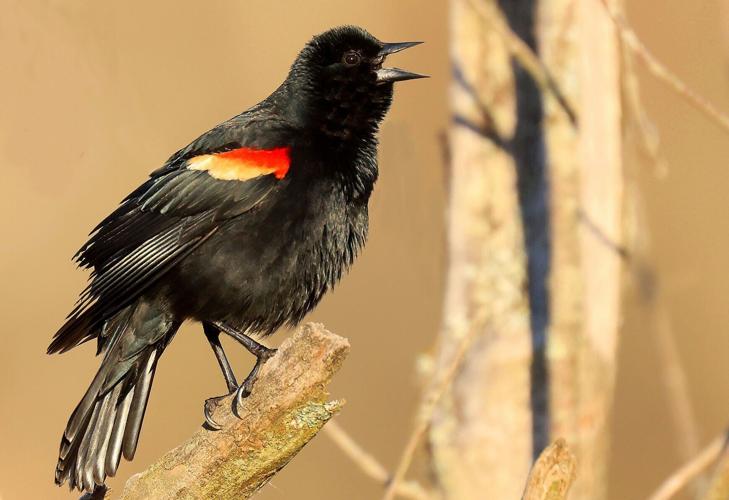Our winter was mild and a lot of the marshes were open, which set up some unusual situations with waterfowl. Tundra swans in huge numbers entertained onlookers on the Feeder Road from January into March before leaving for their nesting grounds in the Arctic.
Some sandhill cranes hung around most of the winter and on two different days I observed groups of 40 to 50 on the Feeder Road — big numbers for the area. Various ducks such as pintails, widgeons, mallards and even a few teals were present.
However, there didn’t seem to be a mass migration of waterfowl like we are used to seeing in the spring. Oh, there were some big flocks of Canada geese moving high in the sky for that one week of great weather, but that was about it. I believe many waterfowl moved north at night during those warm periods that we experienced during late winter.
Now that spring has officially arrived things seem to be getting back to normal. However, I notice some very early nesting by Canada geese. Two weeks ago I saw a pair with eight goslings in tow, and a number of them this past week. Two local pairs of Tundra swans have started incubating eggs and hopefully when the little guys hatch out and start swimming around with Ma and Dad, the large population of snapping turtles in the marshes will not get too many.
There seems to be widespread timing with eagle nesting this year, which may have been brought about by the mild winter. The old eagle nest in Cayuga Pool at Iroquois National Wildlife Refuge was a failure this year. Everything seemed to be going fine but then something happened and the nest went dead. My suspicion is a predator — a raccoon or a fisher — got up in that nest, as the predator guard probably deteriorated long ago. Since the bald eagle was taken off the Endangered Species List, the state Department of Conservation and the US Fish and Wildlife Service have not been putting up or maintaining predator guards on eagle nesting trees. Raccoons are nocturnal and have no problem displacing an adult eagle sitting on a nest at night, when the eagle is at a disadvantage, and then eating the eggs or eaglets. Because raccoon fur prices are so low no one is trapping them and their numbers have gotten very high. Fisher populations have also grown in this area and a fisher is capable of catching a gray squirrel in a tree top, so one would have no problem going from tree canopy to canopy to get to an eagle nest. Presently fishers are protected in Western New York and that is something the DEC needs to address soon.
Although the Cayuga Pool eagle nest was a failure this year, you can still get a good view of one just west of Cayuga Pool about two miles on Route 77. This also is an old, established nest and really gives a better view than the one at Cayuga Pool because it is a little closer, is not obstructed by other trees, and is sky-lighted. At that large overlook on the south side of Route 77 just look to the west slightly and you will see it. A spotting scope here will give you a great view and you will probably be able to see the two eaglets in the nest, as they have gotten quite big and have begun to develop their wing feathers. Be careful driving into and through this overlook, as there are some very nasty potholes the DEC’s Operation Unit has not addressed in a number of years.
Also as a reminder to those who want to try and get close to eagle nests: the rule is that you get no closer than 330 feet. There is another eagle nest off Route 63 at the Iroquois Refuge that the public can view. It is north of Oak Orchard River Road on the west side of Route 63. It can be seen looking west from Oak Orchard River Road from the hilltop (that’s a dangerous place to park, however) or at a small overlook on the west side of Route 63 just north of Oak Orchard Ridge Road. Again a spotting scope is needed for a decent view.
Some of our smaller feathered friends are now showing up too. This past week I had several Baltimore orioles at my place. The male American golden finches have just about completed their summer plumage change to bright yellow. Martins are also beginning to show up. I haven’t seen a hummingbird yet, but I have a couple of feeders up and ready for them as they will be here soon.
Ospreys have also returned to the area and are actively preparing their nests for the summer. In the Alabama Swamps, they build nests from sticks on special elevated platforms provided years ago by DEC personnel. The old telephone poles they were constructed on have predator guards at their bases, so raccoons and fishers are not a problem. Ospreys will also use the big metal power line towers, which also prevent predator climbing.
Weather is improving and there’s a lot going on in the great outdoors to watch, so don’t miss it. Blissfully, there are no commercials!
Doug Domedion, outdoorsman and nature photographer, resides in Medina. Contact him at 585-798-4022 or woodduck2020@yahoo.com.


















Commented
Sorry, there are no recent results for popular commented articles.